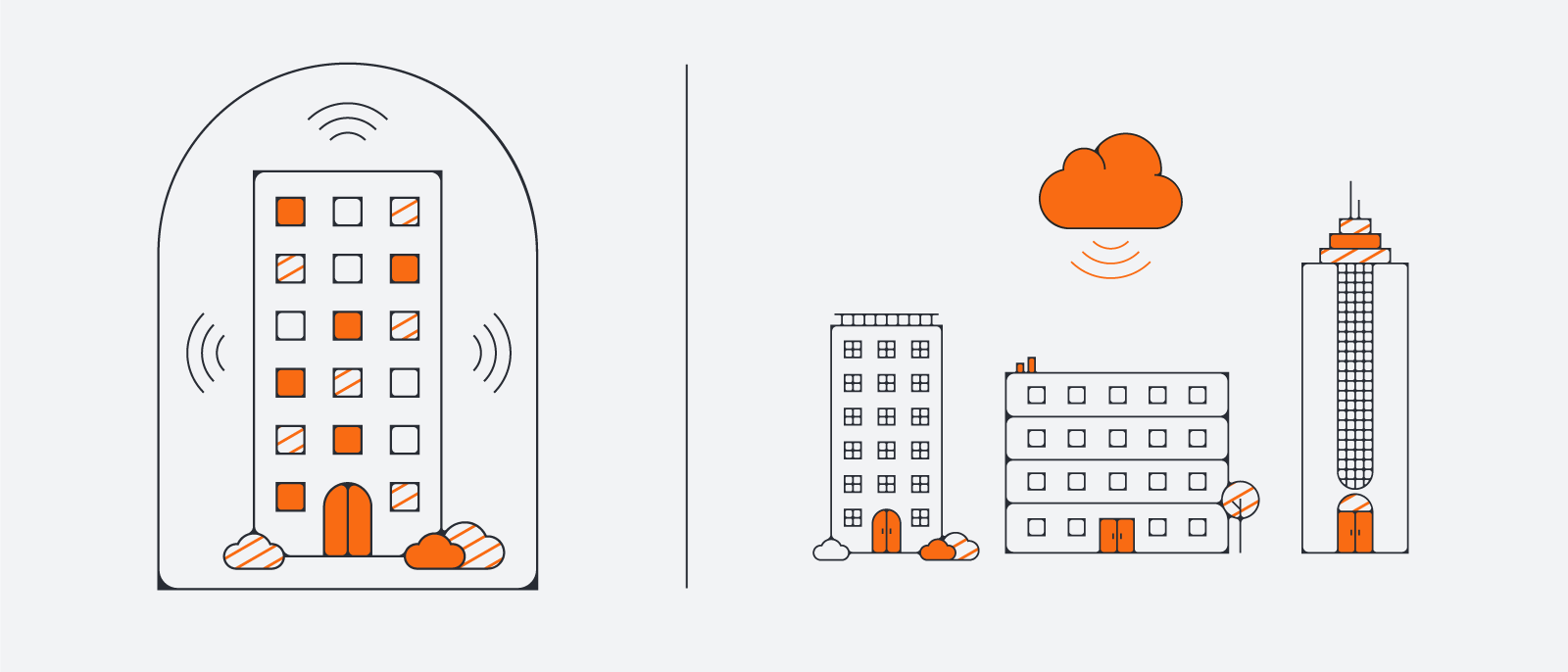
Best practices for managing your hybrid cloud environment
Lucid Content
Reading time: about 9 min
Topics:
Data fuels modern business. Organizations of all sizes now have access to more data to guide their decisions than at any point in history, and it's turned data-access technology into big business.
Data storage and analytics require a robust infrastructure to support it, the most recent advancement being the advent of cloud computing technology. By now, your company likely already operates in the cloud, whether through a public or private cloud, an integration with an on-premises server, or some sort of hybrid cloud environment.
Discover the reasons behind the massive migration to hybrid cloud systems and unpack some practical tips on how to manage your hybrid cloud environment.
Why businesses migrate to hybrid cloud systems
Hybrid cloud systems include any of the various combinations of on-premises and cloud systems. They may be a traditional or legacy system combined with one or more public clouds, a private internal cloud that networks with public clouds, or any similar combination. Businesses choose hybrid cloud systems because they offer seamless scalability—when computing or processing demand increases temporarily or intermittently, on-premise servers can scale their processing and data storage up to the public cloud to handle any excess processing.
This method also provides an added measure of security—utilizing public clouds to handle computing overflow, businesses are only allowing third-party data centers partial access to valuable internal data. The whole system allows effortless flexibility and limitless computing power for non-sensitive processing functions and keeps the more critical information safely protected behind a company firewall.
Businesses are also drawn to the savings provided by hybrid cloud systems. Rather than overspending on additional servers to handle temporary boosts in demand, only to have them sit dormant when the demand drops, hybrid systems give organizations the flexibility to free up internal resources to handle the most sensitive information or applications.
In short, hybrid cloud systems provide three core values to modern businesses: flexibility, scalability, and cost-efficiency, while also creating a secure environment for data exchange.
Types of industries that benefit from hybrid cloud
While every business needs to protect its information, organizations that have to remain compliant with federal privacy regulations find critical security solutions by migrating to a hybrid cloud system.
For example, healthcare organizations are required to meet the privacy standards outlined in the Health Insurance Portability and Accountability Act (HIPAA). They might choose to use on-premises servers to host all private information while using a public or private cloud for all other non-sensitive computing tasks.
Colleges and universities must meet the privacy and security standards drawn out in the Family Education Rights and Privacy Act (FERPA) and might host all student records and financial aid information on on-premise servers while using a private cloud system to handle all other data exchanges.
Similarly, financial institutions required to meet the Payment Card Industry Data Security Standard (PCI DSS) might store all private financial information in on-premises servers while using a secure public cloud system to handle day-to-day transactions.
Consider this example: A university hospital is serious about their HIPAA compliance. As a holder of not just patient records but also financial information related to health insurance companies, they are also serious about PCI DSS compliance. The broader university is responsible for the records of thousands of students, professors, and faculty and must be compliant with FERPA regulations.
In this case, a hybrid cloud system would probably consist of on-premise servers that host and organize all sensitive health information (medical records, etc.), financial information (credit card information, income and financial aid records, etc.) and private student and faculty information (Social Security Number, educational history, etc.), with an additional public cloud service to handle fluctuating computing needs throughout the entire campus, and a private cloud to provide a more limited use, secure system within the network.
It’s important to note that as cloud technology expands, cloud providers are increasingly offering security services compliant with federal regulations like these and have become large driving factors for organizations considering adopting cloud technology.
Cloud growth and emergence by numbers
Cloud service adoption in business IT networks has created a massive industry for cloud service providers. Gartner reports the worldwide public cloud service industry is on track to exceed $266.4 billion in 2020 as global IT spending creeps toward $3.9 trillion. The same report shows global cloud service revenue is forecasted to exceed $354 billion by 2022.
The world's leading cloud service providers are in a heated competition for market share, as Microsoft Azure and Google Cloud currently bow to Amazon Web Services’ 32% market share. Other notable players include Dell Technologies, IBM, Hewlett-Packard Enterprise, and VMware, who all provide multi-cloud hybrid solutions. The emerging patterns of cloud adoption are becoming increasingly complex as cloud providers offer more sophisticated services and as cloud managers continue to adopt hybrid solutions. These complexities aren’t going anywhere soon, so it’s never been more important to learn and understand the best practices for managing a hybrid cloud environment.
Best practices for managing a hybrid cloud environment
There aren’t any shortcuts in hybrid cloud management. Knowing how to approach security, management, and governance is a combination of preparation and patience, but it will separate you from the average IT manager looking to make things easier, not better.
Here are the essentials to hybrid cloud management.
Gain a firm understanding of what is being managed
While it may seem obvious, this crucial step is ignored by many. Cloud managers need to understand the work and applications that will run on public and private clouds—what they do, how end users will interact with them, how they manage data, how they network, and more.
Tech Beacon provides these questions to ask as you’re building your cloud management strategy:
- Who owns the work assignment within the organization? Who gets the call if and when something goes wrong?
- What do the work assignments do for the business, and how crucial are they? The answers to these questions will dictate the resources you allot to managing the work assignments on the hybrid cloud, and the resources you spend should always match the value brought to your business by managing the work assignments.
- When do the work assignments run? Are they continuous or during certain hours during the day? The answer to this will point back to your strategy on how you manage the workload within your hybrid cloud.
- Do these work assignments run on the public cloud, on the private cloud, or in both places? Why? Do those work allotments need to be reassessed?
Focus on understanding security and governance
Security is a top concern of cloud providers, your customers, and your organization’s leadership. An effective hybrid cloud manager is proactive about system security and leverages new resources like IAM (identity and access management) to apply identities to data and devices, controlling who accesses what, and when.
There are two key areas to acknowledge:
1. System security and its effect on performance
Data encryption is a common way of protecting sensitive information, but data encrypted at-rest or in-flight can sometimes lower the overall performance of your cloud system. You should be ready to address this if it comes up, including investing in performance monitoring tools.
2. Policy management and enforcement
Hybrid cloud managers should be well informed on written policies of cloud system governance to make sure they don’t run into any interference with operations.
When it comes to managing these key areas, you can gain visibility into both your on-prem and cloud networks with Lucidchart.
When you automatically generate an architecture diagram of your cloud architecture data with Lucidscale, you can visualize your metadata in the context of your diagram, such as security groups or IP addresses. Then you can leverage your metadata to apply conditional formatting rules and enforce internal best practices by flagging resources, such as unencrypted databases or missing tags.
Create a “single pane of glass”
As a hybrid cloud manager, you have one of two choices: learn all of the native interfaces for all private and public clouds, each with its own system resources and native APIs that control everything from storage management to provisioning, or create a single pane of glass to help manage your system’s complexity.
Investing in tools that will manage cloud services on a single interface will allow you the option to transfer functionality from one cloud to another, saving time, energy, and capital resources. For example, if you need to monitor performance on Amazon Web Services, Google Cloud, and IBM's cloud service, a single pane of glass interface will interpret the differences between cloud service providers on your behalf so you can manage more efficiently.
Make sense of the SLAs
Your SLAs, or Service Level Agreements, are contracts between end-users and hybrid cloud managers alongside cloud providers that stipulate what level of service is being provided, with a risk of penalty if those services are not provided. As the hybrid cloud manager, it isn't enough to hold the cloud provider responsible for meeting their own SLAs—you’re the architect of your cloud architecture and responsible for ensuring your system provides the promised services.
SLAs help to set expectations between users and businesses. Use SLAs as a guide to setting service expectations within the hybrid cloud.
Make yourself familiar with the tools
Hybrid cloud management also involves becoming familiar with the tools available to you. From API management, resource management, performance management, and DevOps management to security management, network management, native platform management, and cloud management platforms, there is a range of tools to choose from to manage your hybrid cloud effectively.
Deciding on the right tools will depend on the strategy and requirements outlined in the steps above and may even mean relying on custom tools. The goal should be automation and efficiency—if work assignment management can't be automated with your available tools and at a reasonable cost, then it's possible that a hybrid cloud may not be the best solution for your organization.
Luckily, with Lucidchart, you can diagram everything from your hybrid cloud environments to your scrum teams and incident management processes. It’s a multi-purpose workspace that helps you gain the necessary insight into your networks and internal processes.
Cloud systems and industries will continue to expand. Gaining a clear understanding of how to manage a hybrid system now will help you adopt new solutions when they appear, effectively manage your cloud architecture, and bring massive value to your organization.

With Lucidscale, you can automatically visualize your hybrid cloud infrastructure to better understand and optimize the cloud.
Learn howAbout Lucidchart
Lucidchart, a cloud-based intelligent diagramming application, is a core component of Lucid Software's Visual Collaboration Suite. This intuitive, cloud-based solution empowers teams to collaborate in real-time to build flowcharts, mockups, UML diagrams, customer journey maps, and more. Lucidchart propels teams forward to build the future faster. Lucid is proud to serve top businesses around the world, including customers such as Google, GE, and NBC Universal, and 99% of the Fortune 500. Lucid partners with industry leaders, including Google, Atlassian, and Microsoft. Since its founding, Lucid has received numerous awards for its products, business, and workplace culture. For more information, visit lucidchart.com.
